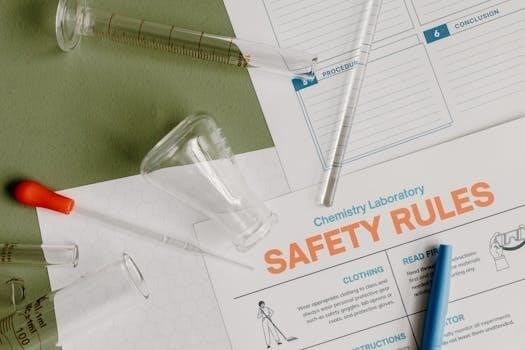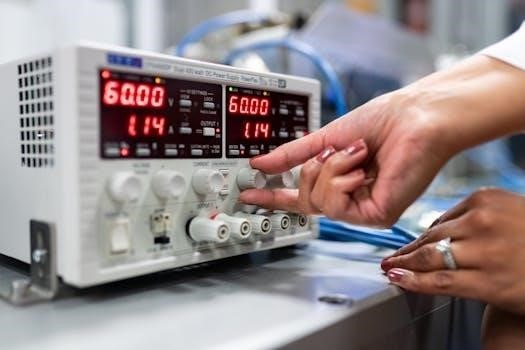Basic Elements of APA Lab Manual Citation
When citing a lab manual in APA style, identify the author, which may be a department or instructor․ Also note the year and semester of publication, and the title of the lab manual, which is formatted like a book title in references․
Identifying the Author of a Lab Manual
In APA style, when citing a lab manual, the author is not always a single person․ Often, it’s the department or institution that created the manual․ For instance, if the “Department of Physics” at a university developed the manual, the department would be listed as the author․ If the lab manual is created by an individual instructor, their surname should be used as the author․ When citing, use the full department name or the instructors name․ Do not use abbreviations of the department names․ It is important to identify the correct author to accurately attribute the source, and differentiate from other similar sources․ This practice follows APA guidelines for referencing works with organizational authors․ If no author is mentioned, the title takes the place of the author․
Year and Semester of Publication
When citing a lab manual in APA format, it’s crucial to include the year and semester the manual was used․ This information helps readers locate the specific version of the manual you referenced․ The year should be placed in parentheses, followed by a comma, and then the semester (e․g․, Fall, Spring, Summer)․ This detail is essential, as lab manuals can be updated frequently, and identifying the exact publication period ensures that your readers can access the same version and understand the context of your citation․ The year is always specified using 4 digits․ This helps to maintain clarity and avoid any potential ambiguity, which could arise from relying on shorter forms․ This practice ensures that the correct version is identified․
Title of the Lab Manual
The title of the lab manual is a key component of the APA citation․ When including the title, it should be formatted like a book title․ This means that you should capitalize only the first word of the title and any proper nouns․ The rest of the words should be in lowercase․ This format helps distinguish the title from other elements within the citation․ It is important to present this information consistently in the reference list, as this is the main way that readers will identify the specific manual you used․ This part of the citation is essential for accurate retrieval of the source․

In-Text Citation of a Lab Manual
When citing a lab manual within the text of your paper, you’ll use either a parenthetical or narrative format․ These citations include the author and year of publication․
Parenthetical In-Text Citation
For parenthetical in-text citations of a lab manual in APA format, include the name of the issuing body, such as a department or instructor’s last name, followed by a comma, and then the year of publication․ This information is enclosed within parentheses at the end of a sentence or clause․ For instance, if the Physics Department created a lab manual published in 2012, the citation would appear as⁚ (Department of Physics, 2012)․ This format allows readers to easily locate the full reference in your reference list․ When using a lab manual, always follow the specific guidelines and examples provided by your professor or institution, as variations in formatting can occur․ When referencing specific pages or sections, include these details within the parenthetical citation using a “p․” for page or a “sec․” for section number after the year, for example, (Department of Physics, 2012, p․ 25) or (Department of Physics, 2012, sec․ 3․2)․
Narrative In-Text Citation
When using a narrative in-text citation for a lab manual in APA style, integrate the author (the department or instructor’s name) directly into your sentence․ Follow the author’s name with the publication year in parentheses․ For example, instead of placing the citation at the end of the sentence, you might write, “According to the Department of Physics (2012), the experiment should be conducted in a specific way․” This method places emphasis on the author and the manual․ This way of writing helps to create a more seamless reading experience․ Always ensure the year of publication is included right after the author’s name when using narrative citations․ When referencing specific pages or sections, include these details within the narrative, such as, “Department of Physics (2012, p․ 25) indicates that…,” or “As explained by Department of Physics (2012, sec․ 3․2),…”․ Remember to include the full citation in your reference list․

Reference List Entry for a Lab Manual
In the reference list, a lab manual is generally treated like a book․ Begin with the author, then the year, title, and publisher information if available, and other relevant details․
Format for a Lab Manual with a Department as Author
When a lab manual’s author is a department, such as the Department of Physics, this is what you should use as the author in your citation․ Start with the department’s full name followed by a period․ Next, include the year and semester the manual was used, enclosed in parentheses, with a comma separating the year and semester․ Place a period after the closing parenthesis․ The manual title is then added, using title case (capitalizing only the first word and proper nouns)․ If the lab manual is published, include the publisher and location details, similar to book citations․ If it’s unpublished, this part is omitted․ This format ensures clarity about the source of your information․ Remember, that the department is responsible for the manual, and thus, is considered the author in APA style when no specific author is listed․

Lab Manuals as Books
According to APA guidelines, lab manuals should generally be treated like books in citations and references․ If your lab manual has a clear author or editor, you should start your citation with their name(s), similar to any book․ This is followed by the publication year in parentheses․ The title of the lab manual comes next, italicized and with only the first word and proper nouns capitalized․ If the manual is a published work, you would include publisher information, such as the name of the publisher and location of publication․ If it is a compilation of various materials, the citation will also need to include this information․ When a lab manual is treated as a book, this provides a standardized method for recognizing the source․ If a book has no clear author, move the title in place of the author․
Lab Manuals With No Author
Sometimes, a lab manual doesn’t have a clearly identified author․ In such cases, the APA style dictates that you move the title of the lab manual to the author position in the reference list․ The title should still be formatted with only the first word and proper nouns capitalized, and it should be italicized․ Following the title, you’ll provide the year and semester of use in parentheses․ If the manual is published, you’ll need to include publisher information․ When citing in text, use a shortened form of the title in place of the author’s name․ This approach ensures that even without a specific author, the lab manual is easily identifiable in your citations and reference list․ This reflects the APA rule that if a source has no clear author, move the title in place of the author․

Additional Considerations
Differentiate between published and unpublished lab manuals; Also, remember to cite specific pages or sections of the manual if needed․ These details enhance the precision of your citations․
Published vs․ Unpublished Lab Manuals
The way you cite a lab manual in APA format depends on whether it is published or unpublished․ Published lab manuals, which have formal publication details like a publisher and city, should be treated similarly to books․ Include the author, year, title, and publication information in the reference list entry․ If a lab manual is unpublished, it usually lacks a publisher and formal details․ In this case, you typically treat it as a gray literature source, and it may not be found in academic databases․ Instead, you would include details about the institution or department that created it, along with the year and title․ It is important to note the distinction, since published materials are more readily accessible, whereas unpublished ones may require a more specific source location․ It may be treated as grey literature, where you should include the department and location where the manual was produced․
Citing Specific Pages or Sections
When referencing specific information from a lab manual, such as data, a procedure, or a particular concept, it’s crucial to indicate the exact location of that information through page numbers or section headings․ In the in-text citation, include the page number(s) after the year of publication, separated by a comma․ For instance, “(Department of Physics, 2012, p․ 25)” refers to page 25 of a manual from the Department of Physics published in 2012․ If you are referencing a specific section instead of a page, mention the section name or number in your in-text citation when appropriate․ This ensures clarity and directs the reader to the precise source of your information․ This approach maintains the rigor of academic writing, allowing readers to verify the context and accuracy of the cited material within the lab manual․
